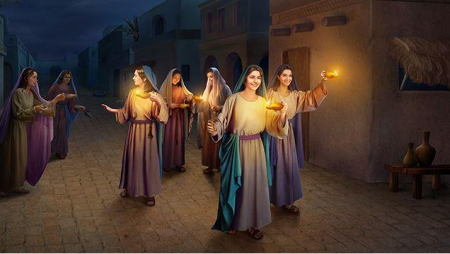New cloth, new wineskins
Luke 5:33–39 (also Matthew 9:14–17, Mark 2:18–22)
And they said to Him, Why do the disciples of John fast often, and make prayers, and likewise the disciples of the Pharisees, but Thine eat and drink? And He said to them, Can you make the sons of the wedding fast while the Bridegroom is with them? But the days will come when the Bridegroom shall be taken away from them, and then they shall fast in those days.
And He also told a parable to them: No one patches an old garment with a patch1 from a new garment; otherwise both the new rips the old, and the patch from the new does not agree with the old.
And no one pours young wine into old bottles2; otherwise the young wine will tear the bottles and spill out, and the bottles will perish. But young wine is poured into new bottles, and both are preserved.
And no one, having drunk the old, straightway desires young, for he says, The old is more agreeable.
Sons of the wedding with the Bridegroom
AC 9182:10. Those are called “sons of the wedding” who are in the truths of the church, and receive good, for the good which is from the Lord is “the bridegroom.” That “the sons of the wedding do not mourn so long as the bridegroom is with them” denotes that they are in a blessed and happy state, thus with the Lord, when they are in truths conjoined with their good. “They shall fast when the bridegroom is taken away from them” denotes that they are in an unhappy state when good is no longer conjoined with truths. This state is the last state of the church, but the former is its first state.
Old and new garments
AC 9212:7. The Lord used this comparison to describe the truth of the new church and the truth of the old church, for the “garment” denotes truth. To “sew” or “add” one to the other is to destroy both....
AE 195:15. Because a “garment” signifies truth, the Lord compared the truths of the former church, which was a church representative of spiritual things, to a piece of an old garment, and the truths of the new church, which were spiritual truths themselves, to a piece of a new garment. He compared them likewise to bottles of wine, because “wine” in like manner signifies truth, and “bottles” mean the knowledges that contain truth.
Old and young wine and wineskins
AR 316:3. “New wine” is the Divine truth of the New Testament, thus of the new church, and “old wine” is the Divine truth of the Old Testament, thus of the old church.
TCR 784. Just so far as the new heaven, which constitutes the internal of the church with man, increases, so the New Jerusalem, that is, the New Church, descends from it. Consequently, this cannot take place in a moment, but it takes place to the extent that the falsities of the former church are set aside. For where falsities have already been implanted what is new cannot enter until the falsities have been rooted out, and this will take place with the clergy, and so with the laity; for the Lord said, “No one puts young wine into old wineskins....”
AE 376:28. This comparison, like all others in the Word, is from correspondences, “wine” signifying truth, “old wine” the truth of the old or Jewish Church, and “wine-skins” things that contain, “old wine-skins” the statutes and judgments of the Jewish Church, and “new wine-skins” the precepts and commandments of the Lord. That the statutes and judgments of the Jewish Church, which related especially to sacrifices and representative worship, are not in agreement with the truths of the Christian Church is meant by “they do not put young wine into old wine-skins, or else the wineskins burst and the wine is spilled; but they put [young] wine into new wine-skins, and both are preserved together.” That those who have been born and educated in the externals of the Jewish Church cannot be brought immediately into the internals belonging to the Christian Church is signified by “no man having drunk old wine straightway desires new; for he says, “The old is more useful.”
1 “Patches ... with a patch” is literally “throws upon... what is thrown upon” in the Greek.
2 made of animal skin
Questions and Comments
- Is there a place in the New Church for fasting as a religious observance (not just for health reasons)?
- In AC 9182:10, can you picture the unhappy state when good is not conjoined with truths, or life is not conjoined with the Lord’s teachings, and life seems purposeless or even evil? Then, can you picture the happy, peaceful state of acting according to conscience from the Word, and so being with “the Bridegroom”?
- In AC 9212:7, why would adding the old, representative truths to the new, internal truths destroy both? Is it mainly because of the way the Jews had abused and twisted the meaning of the Word? This seems to be the case in TCR 784, but is there more to it?
- In TCR 784, what is a falsity of the former church that needs to be set aside to receive the New Church? What is one that affects us here in our church?
| previous |  |
next |
|---|


